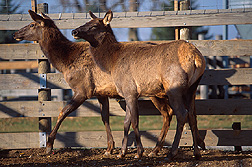Using HOOF-Prints To Track Brucellosis Outbreaks
Finding the source of brucellosis outbreaks has been made easier by a new DNA fingerprinting method developed in Ames, Iowa, by microbiologists with ARS and USDA’s Animal and Plant Health Inspection Service (APHIS).
Brucellosis is a devastating, extremely infectious disease caused by Brucella bacteria that induce abortions in many animals, including sheep, goats, cattle, pigs, elk, and bison. Humans who come in contact with Brucella can get undulant fever, which is marked by chronic flulike symptoms.
Though almost eradicated from the United States, brucellosis still costs livestock producers tens of millions of dollars in testing and losses each year. Outbreaks may cause states to lose brucellosis-free status, meaning their cattle must undergo extensive testing before they can be shipped away. Brucellosis is still common in countries where control programs have failed to reduce animal diseases.
The new technique is called “HOOF-Prints”—for Hypervariable Octameric Oligonucleotide Fingerprints. Developed by microbiologist Betsy Bricker, of the Bacterial Diseases of Livestock Research Unit at ARS’s National Animal Disease Center, and Darla Ewalt, of APHIS’s National Veterinary Services Laboratories, it allows scientists to identify strains of the disease through differences in their DNA sequences and to separate these strains into subtypes.
Finding the source of outbreaks helps animal health officials identify and isolate infected animals and tell whether outbreaks started in wildlife.
“There are few genetic markers for Brucella species that can be used to trace outbreaks,” says Bricker. “HOOF-Prints lets us characterize Brucella isolates through repeated, short DNA sequences—known as tandem repeats—that form ‘hot spots’ for accelerated mutation.”
Through DNA sequencing, Bricker and Ewalt found that the Brucella genome has 10 tandem repeats dispersed throughout its two chromosomes, each of which produces a distinctive genetic fingerprint. “Having this many repeats exponentially increases the assay’s power to characterize closely related strains,” says Bricker.
The new method uses polymerase chain reaction (PCR) technology, which copies large amounts of DNA molecules from small amounts of source DNA. Ewalt says HOOF-Prints is intended to complement existing PCR and bacteriological tests used to identify Brucella species.
Bricker and Ewalt tested their method by examining 27 strains obtained from 5 infected herds in the western United States. These contained 12 different HOOF-Print patterns. “Except for 2 isolates, the fingerprints were identical or very similar, differing at 2 or fewer of the 10 markers,” says Bricker. “This suggested a common source of infection.”
HOOF-Prints was first applied in the field in 2002, when it traced a brucellosis outbreak in Fremont County, Idaho, cattle to local elk.
Bricker says the new technique could eventually be applied toward generating an international database of Brucella fingerprints that can be accessed and used by epidemiologists to one day control the disease.—By Luis Pons, Agricultural Research Service Information Staff.
This research is part of Animal Health, an ARS National Program (#103) described on the World Wide Web at www.nps.ars.usda.gov.
Betsy J. Bricker is with the USDA-ARS National Animal Disease Center, 2300 N. Dayton Ave., Ames, IA 50010; phone (515) 663-7310, fax (515) 663-7458.
"Using HOOF-Prints To Track Brucellosis Outbreaks" was published in the January 2006 issue of Agricultural Research magazine.







